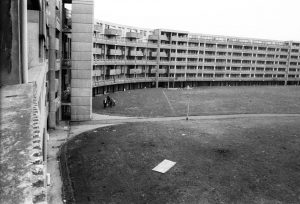Political Theory Research Group series 2016/17: 21 September

Hulme Crescents, Manchester 1979 Photo credit: Alan Denney (CC BY-NC-SA 2.0)
The 2016-17 PTRG Programme kicked off with a cross-disciplinary paper examining the interplay between political theory and architecture. Tahl’s research seeks to apply political theory frameworks not only to overtly political cases but also to approaches and case studies in architecture. In particular he focuses on the process of ‘récupération’, whereby critiques of dominant practices in either politics or architecture are ‘coopted’ by the very practices that they challenge. Through co-optation or récupération such critiques are ‘absorbed by society and transformed from a threat to the system into an integral part of it.’ Building on the work of a range of political theorists, most notably Ernesto Laclau, this paper looks to provide an analysis and reconstruction of this process in order to arrive at a model for better understanding how récupération functions within architecture. Tahl looks to situate this discussion within the context of the influential social critiques which emerged from the protest movements of 1968.


